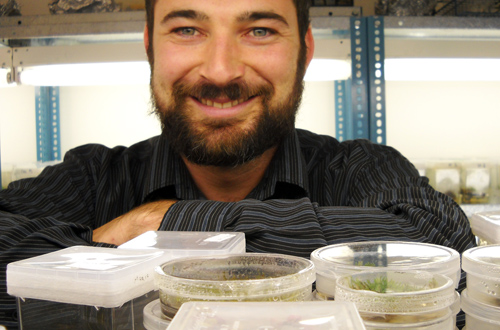
Why are there so many Elm Streets but so few elms? Max Jones started pondering that question while growing up in Elora, Ont. Three university degrees later – including undergrad and master’s degrees from the University of Guelph — he knows all about the fungal disease that has led elm trees nearly to extinction across North America.
Now back at his alma mater as a professor in plant agriculture, Jones is asking other questions, including this one: How might we find efficient, effective ways to repopulate our towns and forests with native elms and other plants threatened by disease organisms?
Once, American elms with their graceful architecture helped to fill out our forests and cities. Today only about three per cent of the trees still stand in Ontario. Most specimens were wiped out by Dutch elm disease, a fungus spread by beetles.
Those few specimens still dotting the landscape, including a century-old giant towering over U of G’s Macdonald Hall, are either lucky or resistant to the fungal affliction, says Jones.
It’s those trees with built-in resistance to the disease that interest him and other members of the Gosling Research Institute for Plant Preservation (GRIPP), which opened in 2011 at the University of Guelph.
The institute is supported by millions of dollars in funding from the Gosling Foundation, a non-profit ecological organization co-founded by Philip and Susan Gosling.
Plant agriculture professor Praveen Saxena, GRIPP director, says up to half of the world’s plants face extinction within three decades from disease, pollution, climate change and other human activities.
“Such rapid loss of plant diversity threatens the health and resilience of all ecosystems,” Saxena said during a Gosling funding announcement in summer 2013. “It’s happening fast, and most trees are affected.”
Earlier last year, he and other U of G researchers cloned American elms that had shown resistance to Dutch elm disease. They are now looking at cloning and cryopreservation methods to help preserve other threatened tree species, including maple, ash and chestnut.
A cryopreservation facility opened this year at the institute allows scientists to “deep-freeze” tissue from endangered plants – basically banking disease-resistant trees that might one day be reintroduced into their natural environment.
It’s that last part that especially drives research for Jones, an expert in plant propagation and production.
Rather than squirrel away genetic treasure, he hopes to put trees where they belong: out in the wide world. “The best way to preserve plants is to plant more of them,” he says.
It’ll take a while to restore American elms to the landscape. Scientists are still hunting down naturally resistant trees and perfecting tissue culture methods to clone and propagate them.
Guelph is also home to the Elm Recovery Project, begun in the late 1990s by the late Henry Kock, former interpretive horticulturist at the U of G Arboretum. In this project, researchers collect material from remaining elms around Ontario to maintain a seed orchard and grow new disease-resistant trees.
Sean Fox, assistant Arboretum manager and head horticulturist, says Jones’s work is vital to the ultimate goal of reintroducing elms to the landscape. His research, says Fox, will “help us understand why some of these trees seem to be able to survive the disease. What are those inner workings that separate these strong survivors from the 98 per cent that don’t make it?”
Back in the Bovey Building and adjoining greenhouses, Jones is busy coaxing along material in lab dishes, including tissue from the Arboretum project. He and Saxena have developed a system to regenerate American elms from single cells.
Using cloned cells rather than growing new trees from seed involves a trade-off.
By mixing genes, seed-grown plants help keep up genetic diversity. More diversity can mean more natural disease resistance. That strategy hasn’t worked for elms, says Jones. Cloning plants gives up diversity for the potential to make lots of new elms – and notably elms screened for resistance — more quickly.
Using tissue culture, scientists screen plants for desired traits and then mass-produce them. Every plant cell has the potential to develop into a brand-new plant – in theory, says Jones.
Not every plant co-operates with the theory. He aims to understand why some plants are recalcitrant, and improve propagation and production methods.
He’s looked at particular plant compounds involved in growth and development in the lab dish, including chemicals involved in plant defences. Some of those compounds such as phenolics cause browning of plant tissue and, in extreme cases of self-defence in the lab dish, can even kill the plant itself. “It thinks it’s under attack,” says Jones.
He and Saxena have identified an inhibitor to prevent browning of cloned plant tissue.
More generally, he says, understanding chemical pathways might help researchers develop plants that are difficult to grow in vitro, including breadfruit.
After his B.Sc. and M.Sc. here with Saxena, Jones did a PhD at the University of British Columbia with Susan Murch, another former grad student of Saxena’s. She has developed a mass propagation method for breadfruit.
Jones worked with her on screening and propagating nutrient-rich breadfruit varieties suited to growing conditions in the world’s wet tropics.
That ongoing project is led by Global Breadfruit, a group including Murch that produces trees for distribution to non-governmental organizations in countries ranging from Jamaica to Ghana to Myanmar. Partners are Trees That Feed Foundation and the National Tropical Botanical Garden in Hawaii.
Improving food security is the goal for farmers and consumers in those nations, says Jones: “They need a good staple food, and breadfruit fits that bill.”
He returned to U of G as a post-doc; his faculty position began this past summer. Now living near Elora again, Jones keeps a garden containing what he calls exotic species, including haskap, an edible honeysuckle.